Let’s make it a non-event
September 27, 2012
When it comes to traffic, nobody is savvier than the L.A. driver.
We check the traffic report before we leave the house, guard favorite surface street alternatives like state secrets, and know that a fender-bender on one side of town can quickly morph into commuting misery many miles away.
In other words, we know that we’re all in this together.
That’s why we were able to prove all the skeptics wrong last year when we sailed through Carmageddon without a SigAlert in sight. People heeded the warnings, stayed well away from the 405 Project construction zone and—strangely enough—ended up making it a weekend that Los Angeles long will remember fondly.
Now we have an opportunity to do it all again. Our destiny is once more in our own hands as Carmageddon II closes down a 10-mile stretch of the nation’s busiest freeway, the 405, for 53 straight hours this weekend to allow for the safe demolition of the Mulholland Bridge as part of an ambitious freeway widening and modernization project.
The first on- and off-ramps will start closing at 7 p.m. on Friday, and by midnight, the entire freeway will be shut down in both directions, all the way from the 10 Freeway to the 101.
Clearly, despite the positive outcome last summer, the potential for major gridlock is still there. You can’t take away a route traveled by a half-million motorists every weekend and expect things to go smoothly—unless we all change our ways for 53 hours.
But Angelenos proved during the first Carmageddon that changing our ways isn’t just about meeting our civic responsibility. It also can be a heck of a lot of fun.
So please, follow the official advice to stay out of the construction area and eat, shop and play locally. It’s a welcome chance to get to know our own neighborhoods better, to patronize a local business that we’ve been meaning to try, or to check out a nearby arts happening.
Or if you prefer to venture out of your neighborhood, leave your car at home and test-drive our constantly improving public transit system. Since the first Carmageddon, Los Angeles has gained more than 12 miles of new mass transit lines: the Expo Line light rail running from downtown L.A. to Culver City, and the Orange Line Extension rapid transit busway from Warner Center to Chatsworth.
This weekend, both lines can serve as portals to the big wide world beyond the Carmageddon II impact zone, especially for residents of the Westside and the San Fernando Valley. Riding the Orange Line Extension to Chatsworth, for instance, makes it possible to connect with Amtrak and ride up the coast for a stress-free, car-free weekend in Santa Barbara. Hopping aboard Expo in Culver City offers an easy way to get to destinations including the county Natural History Museum in Exposition Park or LA Live downtown, where the Herbalife Triathlon Los Angeles finishes around mid-day on Sunday. The possibilities are endless.
However you spend Carmageddon II weekend, have fun, stay out of the car as much as you can and try to see it as a needed respite from our busy, on-the-go lives.
Monday morning will be here before you know it.
For detailed maps of where the construction is happening, and how to avoid it, click here. In addition, Caltrans’ new QuickMap offers up-to-the-minute reports on road conditions. Be sure to click the “slow-fast” icon at the top of the left-hand column for color-coded real-time traffic information.
Posted 9/27/12
Have they got a deal for you
September 27, 2012
Sure, you could sit around and mope all weekend, fretting about the 53-hour closure of the 405 Freeway.
Or you could come out of Carmageddon II with a free bagel, a discounted letterman jacket and some newfound pole dancing skills.
Already feeling separation anxiety from your car? A complimentary 15-minute chair massage from Physical Therapy Solutions could help you cope. Fear of driving in a post-Carmageddon world? Hypnosis might work, and the price of the first session is 50% off at Scripting Your LifePlay.
As Los Angeles prepares to confront a second Carmageddon weekend on Sept. 29-30, the discounts, freebies and special offers are flying. Many neighborhood businesses are hoping for a boost from local customers sticking close to home for the weekend, as well as from those ditching their cars in favor of public transportation to get to attractions and services throughout the region.
Metro, which along with Caltrans is responsible for the massive 405 improvements project that includes Carmageddon II, has been working feverishly to turn the lemon of a lengthy freeway closure into some sweet, bargain-hunting lemonade.
An unprecedented expansion of the agency’s 10-year-old Destination Discounts program has brought hundreds of businesses into a special Carmageddon-themed initiative, complete with interactive map.
“To just say to people ‘eat/shop/play locally’ is not enough. It needed to have legs, it needed to have incentives attached to make it real, to make it viable,” said Fran Curbello, the Metro communications manager heading up the initiative. “We gave our business community a chance to be part of the solution.”
While some of the deals require presentation of a Metro TAP card, other businesses are extending their discounts and freebies to all comers this weekend—no questions asked.
At Select Beer Store in Redondo Beach, for instance, customers can just say “Carmageddon” to claim a free bag of chips as they order a brew (while supplies last!)
Although Metro’s primary objective is to get people riding public transit, it also has an interest in helping folks find diversions close to home this weekend. Curbello suspects that most merchants won’t particularly care whether their customers arrive by bus, bike or (gasp) automobile, as long they’re staying in the neighborhood—and away from the 405 construction zone.
“It’s good business,” she said.
The participants range from mom-and-pop eateries to big hotels and major museums. The Los Angeles County Museum of Art, for example, is offering ½ price admission to everyone who comes “via an alternate mode of transportation.” At another point on the artistic spectrum, Madame Tussauds Hollywood is having some fun with numbers and offering a 40.5% discount (get it?) on adult and children’s tickets. (Enter promo code 4050 if ordering online.)
Even for armchair bargain-hunters, Metro’s interactive Eat/Shop/Play map is worth a few clicks, just to marvel at the idiosyncratic glories of Los Angeles itself as it goes on sale for the weekend.
There are traveling notaries (J Lawson Mobile Notary of North Hollywood) and educators who make house calls (Tutor Doctor of Van Nuys.) There are horses to ride at the Sunset Ranch near the Hollywood sign and Segways for hire in the South Bay. Xtreme Martial Arts is offering discounts in North Hollywood and Rise-The Studio in Santa Monica is pushing 25% off all its “meditative and playful pole dancing classes” on Sept. 29 and 30.
Then there’s the food. Lots of it.
Most of the participating restaurants are offering discounts, but many are throwing in freebies.
“I’m ready to give away some hot links, that’s what I’m gonna do,” said Kevin Huling, owner of Les Sisters Southern Kitchen in Chatsworth, who’s hoping the new Orange Line extension will help bring customers his way. “I am hoping more people come down here. It’s a bit of a walk, but we’re walking distance from the Chatsworth Station.”
The moveable feast also includes free naan bread at Saffron in the Baldwin Hills Crenshaw Plaza, an on-the-house bagel for transit riders at the Onegeneration booth at the Encino Farmers Market, and a free side dish or beverage at Mel’s Fish Shack on West Jefferson, near the Expo Line’s Farmdale Station.
Those seeking a more lasting souvenir of Carmageddon II might consider making an automotive style statement with tire rims from EZ Rims 4 Rent on Crenshaw Boulevard. For this weekend, they’re offering $50 off purchase and rent-to-own transactions.
“Hopefully it does pretty well,” manager Fidel Ozuna said. “We are anticipating a pretty decent weekend.”
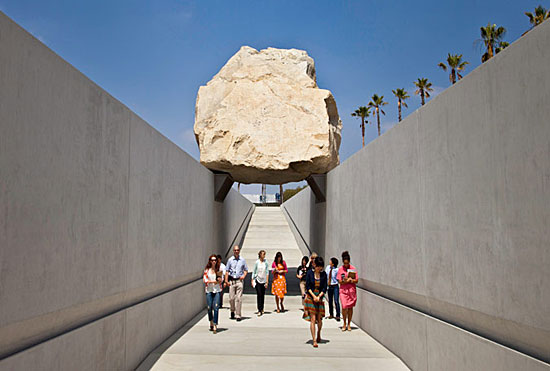
Have you seen The Rock yet? LACMA's half price this weekend if you get there via alternate transportation.
Posted 9/27/12
Check out Carmageddon II detour maps
September 25, 2012
If you absolutely, positively must drive this weekend, here’s your road map for steering clear of trouble.
While there’s no official map of surface street routes for navigating Carmageddon II, Metro has produced maps showing how local and regional freeways will move around the construction zone.
Wherever you’re heading, your object should be to stay as far away as possible from the 405 Freeway, which will be closed from the 10 to the 101 on Saturday, Sept. 29 and Sunday, Sept. 30. Ramps will begin closing 7 p.m on Friday, Sept. 28, with full closure of the freeway in both directions beginning at midnight.
Things are set to reopen, after a full 53 hours of construction work, at 5 a.m. on Monday, Oct. 1. The work is needed to demolish the north side of the Mulholland Bridge, which will be torn down and rebuilt as part of a massive improvements project through the Sepulveda Pass.
The official mantra is stay close to home, patronize local businesses, savor your own neighborhood and give your car the weekend off. But if you have to drive, these maps will help guide you around the project zone and Southern California as a whole.
For a closer look at the northbound closure zone, click here. The southbound details are mapped out here.
Posted 9/25/12
Return of Carmageddon
August 27, 2012
Carmageddon, last summer’s blockbuster traffic success story, is back with a fall sequel. And to keep Part II from turning into the disaster predicted—and averted—the first time around, officials say it will be more important than ever to go “car-light” or “car-free” during the last weekend in September.
Starting around 7 p.m. on Friday, September 28, ramps to the 405 Freeway will begin closing in advance of a weekend-long shutdown of the entire freeway through the Sepulveda Pass.
The full, 10-mile stretch of the 405 running from the 10 Freeway to the 101 will be closed all of Saturday, September 29, and Sunday, September 30. It is set to reopen at 5 a.m. on Monday, October 1.
Avoiding epic gridlock for a second time may be a tall order, but officials said they are confident the public can pull it off.
“During Carmageddon I, drivers proved the skeptics wrong,” said Supervisor and Metro Director Zev Yaroslavsky. “They heard our warnings and stayed off the roads…And I have every confidence they’ll rise to the occasion again.”
The planned 53-hour closure of the freeway is needed to dismantle the north side of the Mulholland Bridge over the 405. The south side was demolished last summer, but it has taken longer than expected to rebuild, leading to delays in scheduling Carmageddon II.
Picking a suitable weekend meant juggling around big dates like the start of the fall quarter at UCLA (September 24) and transporting the Space Shuttle Endeavor from LAX to the California Science Center in Exposition Park (likely sometime in October.)
The weekend of September 29-30 “was the least impact, that we could tell,” said Mike Barbour, who’s heading up the project for Metro.
The project is part of a major, multi-year effort to build a 10-mile northbound carpool lane on the 405 Freeway, along with other improvements, including redesigned flyover ramps at Wilshire Boulevard. Overall, the project is running four to six months behind schedule, but officials are optimistic they can make up some of that time and still reach “substantial completion” next year.
Work wrapped up 17 hours early during the first Carmageddon—a pleasant surprise that’s unlikely to be repeated this time around, Barbour said.
“There’s more to knock down and more to remove,” he said, adding that workers also will be taking advantage of the lengthy closure to get a jump on maintenance and construction work elsewhere on the freeway.
“The project is pushing to get this job done as soon as possible,” he said, “so we can get out of everybody’s hair.”
Posted 7/19/12
Your guide to Carmageddon II
August 27, 2012
Whether you’ve been following every twist and turn of the 405 Project as it progresses or are just trying to catch up on the latest strategies for coping with Carmageddon II, an upcoming community meeting can help.
At the September 6 meeting, officials will present information about all the closures, detours and alternative routes being developed as Los Angeles gets ready to navigate the second coming of Carmageddon. That long-running closure of the entire 405 Freeway between the 10 and the 101 takes place the last weekend in September.
The first ramps will begin closing at 7 p.m. on Friday, September 28. The full freeway will be closed on Saturday, September 29, and Sunday, September 30, and is set to reopen at 5 a.m. on Monday, October 1. The closures are needed so workers can demolish the north side of the Mulholland Bridge over the freeway—part of a wide-ranging project to bring a northbound carpool lane and other improvements to the stretch of the 405 that runs through the Sepulveda Pass.
The community meeting will take place at Ahmanson Hall in the Skirball Center, 2701 North Sepulveda Boulevard. Free parking will be available in the north garage on the Skirball grounds, and in the east garage on the east side ofSepulveda Boulevard.
During the original Carmageddon last summer, motorists heeded the official warnings about staying off the roads and things turned out better than expected. This time around, the message to the public has been tweaked and officials are advising people to “Plan Ahead, Avoid the Area, or Eat, Shop and Play Locally.”
Posted 8/27/12
Big wheel turning
August 8, 2012
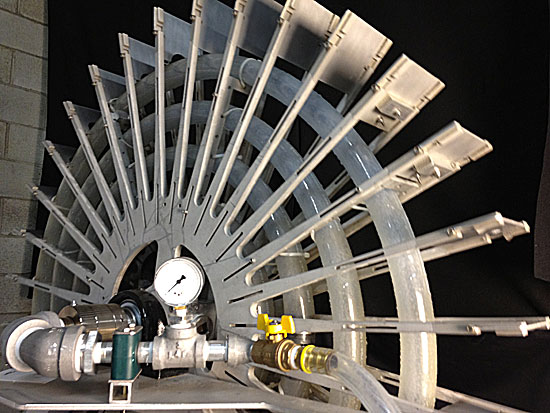
The water wheel, shown above in early prototype, would reconnect L.A. to its river and irrigate the state park.
Lauren Bon planted green rows of corn on a once-forsaken brown field in downtown Los Angeles. She enlisted military veterans to help her cultivate strawberries hydroponically on the V.A. grounds in West L.A. And now she’s preparing to make another big statement—in the form of a massive, working water wheel intended to reconnect Los Angeles with its river, its history and its current environmental realities.
The water wheel is the central element in an ambitious artwork/environmental project to be created next year on a sliver of land beside the Broadway bridge over the L.A. River. The site is right next to the Los Angeles State Historic Park at the edge of Chinatown, where Bon’s “Not a Cornfield” transformed the landscape in 2005.
Drawing on the historic water wheels that dotted Los Angeles from 1854 to 1900, this latest endeavor is being timed to coincide with the 100th anniversary of the dedication of the Los Angeles Aqueduct—November 5, 2013. The project seems destined to spur new discussion of the landmark moment in Los Angeles history when William Mulholland first watched Owens Valley water transported along the 233-mile aqueduct gush into the San Fernando Valley and famously declared, “There it is. Take it.”
While the aqueduct’s legacy has been seen variously—and often simultaneously—as an environmental tragedy, a monumental rip-off and an essential step in enabling the growth that created modern day Los Angeles, the water wheel project seeks less to judge than to inspire fresh thinking about the future.
“I think it’s really critical for us to take a pause and think about our definition of the city,” Bon says. “My position is that it’s time to look at the next hundred years. This work is about saying we need to do a lot better very quickly with figuring out two things: how to retain our water and how to send the rest of it out to sea cleaner.”
Indeed, the water wheel—to be known by its Spanish name, “LA Noria”—is expected to play a hard-working role that goes well beyond its aesthetics. Powered by the flow of the L.A. River, the turning wheel would lift river water in buckets high above the ground. The lifted water would be filtered, transported via a flume or pipe and used to irrigate the 32-acre state park while the rest rejoins the river on its way to the ocean. The project team estimates the wheel could provide 28 million gallons a year for park irrigation, potentially a $100,000-plus annual savings.
Mark Hanna, an engineer with Geosyntec Consultants who is working on the project, says the river, with 80 cubic feet of water per second flowing through “at the lowest point in the driest season,” is perfectly capable of powering the wheel.
The project to build the 60-foot wheel, with 30 feet visible above ground, is being developed and designed by Bon and her Metabolic Studio, a philanthropic endeavor of the Annenberg Foundation, of which she is a vice president and director. Exact costs aren’t yet known but are expected to reach several million dollars by the time the project is finished.
Building the wheel is one challenge. Navigating the complex maze of official permissions needed to make it a reality is another.
The public affairs lobbying firm Kindel Gagan has been hired to obtain the approvals and permits, and the firm’s Michael Gagan says he’s encouraged by initial meetings with the vast array of agencies involved.
They include the Metropolitan Transportation Authority, which owns the land, and the county Department of Public Health, which must issue a permit allowing use of the river water for irrigation. No fewer than four city departments also must sign off on different aspects of the plan—Water and Power, Planning, Building and Safety and the Bureau of Engineering—along with the state parks department, the Regional Water Quality Control Board, the county Flood Control District and the U.S. Army Corps of Engineers. Metrolink, whose trains run right past the site regularly, also is an interested party.
The Los Angeles River Cooperation Committee, a joint city-county working group that evaluates upcoming river projects, gave the water wheel its blessing at its July 9 meeting. “We think it’s super-exciting,” said Carol Armstrong, who heads the L.A. River Project Office of the city Bureau of Engineering.
At the moment, the clock is ticking—literally—inside the studio, where an electronic red countdown sign marks off the time remaining until the aqueduct’s 100th anniversary.
Still, Bon doesn’t doubt for a minute that her project will be able to beat the clock.
“It’s gonna happen,” she says.
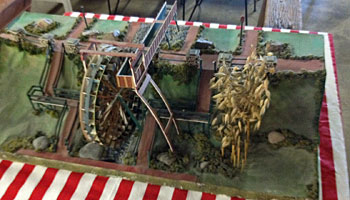
A community activist shared this model depicting the neighborhood's original water wheel as it might have looked in the 1850s.
Bon, who always likes to introduce what she calls a “device of wonder” into her projects, including “Strawberry Flag” at the V.A. and “Not a Cornfield” in the State Historic Park, sees the water wheel as a natural extension of that work. “These aren’t just surprising little projects that are popping up,” she says. The water wheel is “part of three signature projects that all share a definition of the city.”
The wheel also relates to another project currently underway called “Silver and Water.” That expansive, multimedia work-in-progress aims to tell the story about how the “alchemy of photography and Hollywood,” fueled by silver mined in the Inyo ranges and water from the Eastern Sierra, helped create the movies—and Los Angeles itself. One of the project’s elements is a traveling “liminal camera”—basically a massive pinhole camera capable of taking huge photographs—that has been built in a reclaimed container on a flatbed truck.
On a recent day, the liminal camera, which Bon dubs “the largest pocket instamatic camera in the world,” was parked outside the studio, close to where the water wheel would be built.
Inside, another machine, in the form of a working, aluminum prototype of the proposed water wheel, stands ready to make a public debut this week. While the model doesn’t show exactly how the water wheel will function in its final incarnation, it will be Exhibit A at a community open house on Thursday, August 9. The gathering runs from 6 p.m. to 8 p.m. at Metabolic Studio, 1745 N. Spring St., Los Angeles, with the parking and entrance located off Baker Street.
Even before the open house, Solano Canyon resident Alicia Brown said awareness of the water wheel project is building in the area. “Most of my neighbors, they know. Some have taken it lightly; others are amazed,” says Brown, who’s lived in the neighborhood since 1939.
Brown dropped by Bon’s studio recently with her own tabletop model of the historic water wheel that in the 1850s served her community, not far from where Bon’s project is to be installed. An architecture student built the model and gave it to her years ago; now she thinks it could help inspire the new incarnation. Although it’s likely that the new water wheel will be made of metal, Brown is holding out hope for wood, to more closely replicate the original.
“I’ve always loved this neighborhood so much,” says Brown, a neighborhood activist and history buff who for years has been fascinated by Solano Canyon’s vanished water wheel. “There was one there, and people should know.”
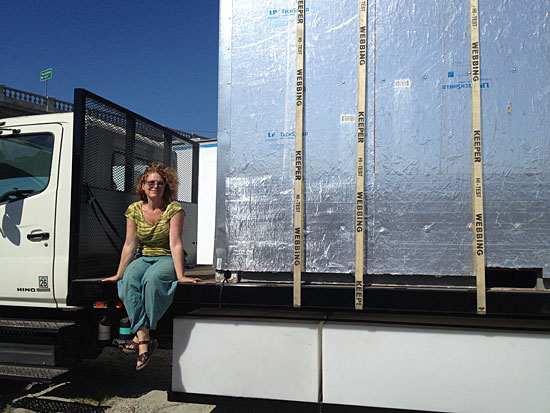
Artist Lauren Bon with Metabolic Studio's "liminal camera," near the site of the proposed water wheel installation.
Posted 8/8/12
Stay local, L.A.
August 2, 2012
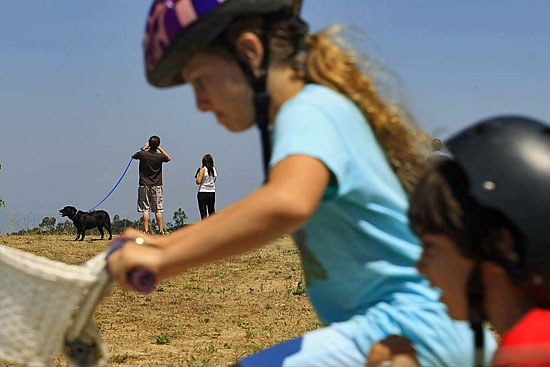
Ditch the car, hop on your bike and explore your neighborhood during Carmageddon II. Photo/L.A. Times
In the days after Carmageddon turned Los Angeles into a car-free Carmaheaven last summer, one of the comments I heard most often was: “Can you do this every month? We had a ball right in our own neighborhood.”
Unfortunately—or fortunately, depending on how you look at it—closing down the nation’s busiest freeway for an entire weekend isn’t something we do very often. But it is something we have to do one more time so that workers can demolish the north side of the Mulholland Bridge over the 405 Freeway in the course of 53 hours during the last weekend in September.
Carmageddon II, as we’re calling it, is an essential part of the project to modernize and add capacity to this heavily traveled stretch of freeway. And like the last time, this lengthy planned shutdown carries with it the potential for serious gridlock throughout the region if motorists ignore the warnings to steer clear of the area.
But it’s also an opportunity.
With so much going on around town and so many self-imposed pressures to stay constantly on the go, we rarely give ourselves permission to take the weekend off and savor the pleasures of simply hanging out in our own neighborhoods.
Los Angeles, consider this your permission slip. And while you’re at it, give your car the weekend off, too.
Your local business owners will thank you for it. Last summer, many of them took a hit during Carmageddon. This time around, there’s no reason to tank the local economy just to help make Carmageddon II a success. Local restaurants, shops and movie theaters are eager for your business. Whether you rediscover your neighborhood on foot, bike or public transportation, you’ll be doing them—and the rest of us—a big favor by staying close to home.
This isn’t just some feel-good exercise. It’s essential to getting through another potential traffic mess just as successfully as we did the last time. After all, the 405 is part of a massive, interconnected system. Its connecting freeways, the 10 and the 101, have plenty of their own heavy traffic to contend with at the best of times, and are also likely to feel the impact if motorists decide to tempt fate and venture out onto local roadways during Carmageddon II.
The good news is that Los Angeles drivers are as savvy as they come. Last summer, a healthy measure of fear, public spiritedness and enlightened self-interest kept most people off the roads during Carmageddon. A team of experts from UCLA and Rand analyzed the data and found traffic was down in some areas by more than 70%, compared to a typical summer weekend.
There’s no reason to think we can’t do that again. In fact, there’s more reason than ever for all of us to do our part.
Construction crews will once again be battling the clock, only this time they will have one-third more work to do in the same amount of time. Last year, they were able to finish early. This year, they’re likely to need all the time available—from the first lane closures at 7 p.m. on Friday, September 28 until the freeway reopens at 6 a.m. on Monday, October 1. For these workers, the pressure is on, big time.
For the rest of us, there’s another kind of pressure: to live up to our past Carmageddon success without getting complacent.
But the rewards are many. So please, mark your calendar and start planning to spend the last weekend of September eating, shopping and playing close to home. See you around the neighborhood.
Posted 8/2/12
Skirball demo prompts freeway closures
July 24, 2012
Even before Carmageddon II comes to town, sections of the 405 Freeway will be shutting down overnight for the next two weeks so that the south side of the Skirball Bridge can be demolished.
The entire southbound 405 will be shut down on July 24, 25 and 30 from the 101 Freeway to Getty Center Drive. Ramp closures will begin as early as 7 p.m., with the full southbound freeway closing from midnight to 5 a.m.
The northbound 405 is set to close on July 26, 27 and 31, and on Aug. 1, 2 and 3, from Getty Center Drive to Ventura Boulevard. Those closures will follow the same pattern, with ramps shutting down around 7 p.m. and the entire northbound freeway closing from midnight to 5 a.m.
The Skirball Bridge over the freeway will itself be closed from 10 p.m. through 6 a.m. every night from July 30 to August 3.
The bridge is one of three overpasses that are being torn down and rebuilt during the multi-year project to create a 10-mile northbound carpool lane on the 405, along with other improvements.
Demolition of the Skirball and Sunset bridges has required a series of overnight closures of segments of the freeway. But taking down the Mulholland Bridge is a more complex job requiring the full, weekend-long closure of the entire stretch of the 405 between the 10 and the 101. The first Carmageddon, in which the south side of the bridge was torn down, came to a successful conclusion last summer when the work was finished earlier than expected and widespread predictions of traffic gridlock averted.
Carmageddon II is set to take place the last weekend in September. Officials are urging motorists to once again stay off the roads. And they warn that this time around, the work is likely to require a full 53 hours to complete.
Posted 7/24/12
Meeting to preview the road ahead
July 24, 2012
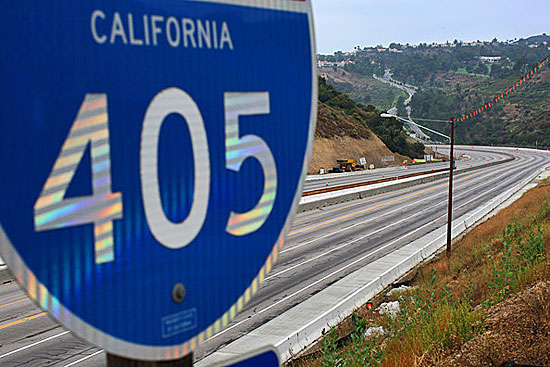
As the 405 Project moves forward on multiple fronts, a community meeting has been set to preview what's next.
If you live or drive near the 405 Freeway, it’s impossible to miss the massive construction project going on in the Sepulveda Pass. This week, a community meeting offers a chance to learn more about what’s ahead—and how best to navigate delays and detours as the project moves forward on multiple fronts. The meeting takes place at the Mirman School Auditorium, 16180 Mulholland Drive, on Thursday, July 26, from 6 p.m. to 8 p.m.
The first hour of the meeting will consist of a presentation on Carmageddon II—the upcoming 53-hour closure of the freeway—as well as details on the September opening of Sunset Bridge and the reconstruction schedule for the Wilshire ramps. The remaining hour will be devoted to questions and answers.
For more information, contact Metro Community Relations at (213) 922-3665 or [email protected]. You can also get updates on the project page and The 405 Report.
Posted 7/24/12




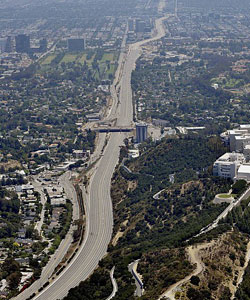
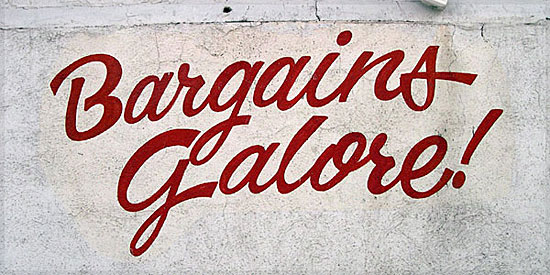
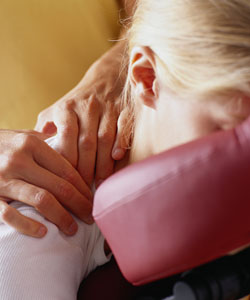
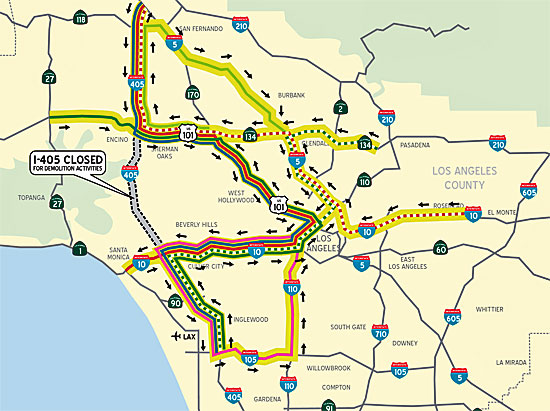
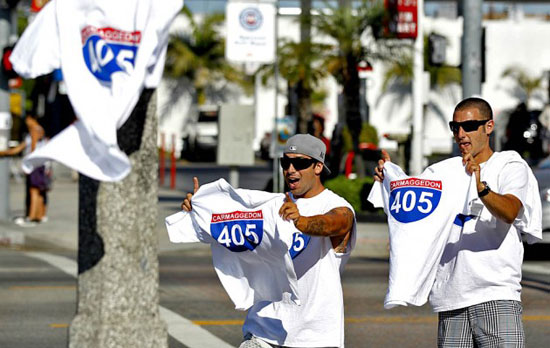
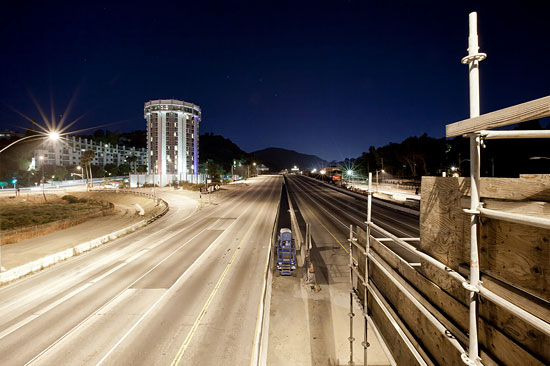

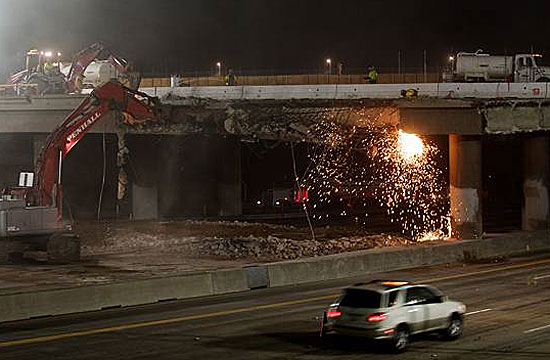







 405 bridge work causes a stink
405 bridge work causes a stink

